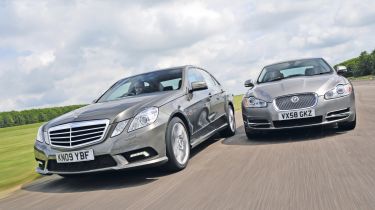Mercedes E220 CDI Sport
Does newcomer offer enough to return to top of exec class?
Mercedes has an unrivalled pedigree when it comes to prestige saloons, but while the S-Class rules the luxury roost, the E-Class has been an also-ran in the executive sector for the past few years. So the new model needs to hit the ground running – and from the outside it fails to make a big impression.
Jaguar faced the same predicament when developing the XF, and came out all guns blazing with a dramatic new style. But the E-Class is underwhelming. Despite its twin headlamps, it looks like a bigger version of its C-Class stablemate. In Sport trim you get smart 18-inch alloys and an AMG bodykit, although it still lacks its rival’s presence.
The fresh shape works in the wind tunnel, though, because Mercedes says its low-drag newcomer is the world’s most aerodynamic luxury saloon.
Unfortunately, the cabin isn’t so sleek. Its angular dashboard is smart but uninspiring, and dominated by swathes of black plastic. The firm’s expensive COMAND control system is showing its age, too. The £2,129 set-up includes sat-nav, a USB and iPod connector and a built-in hard drive to store digital music files, yet its controls are made to feel cumbersome by the Jaguar’s touchscreen display.
From behind the wheel the windscreen is unusually close and upright, which is great for visibility as the pillars do not obstruct your view approaching roundabouts. And there’s plenty of scope to adjust the driving position, too. In the back, legroom is comparable with that of its longer British rival and the E-Class also matches the Jag’s generous 540-litre boot. However, folding rear seats are optional – you have
to pay £391 extra.
Up front, the 2.1-litre engine has a typical diesel rattle that doesn’t really improve on the move. The four-cylinder direct-injection twin-turbo produces 168bhp and a hefty 400Nm of torque at only 1,400rpm, but it sounds coarse next to the smooth 3.0-litre Jaguar. And with fewer cylinders and a smaller capacity, it lacks the XF’s outright punch, too. Our car took 8.5 seconds to cover 0-60mph – that’s 1.9 seconds slower than its British-built rival.
On the road the Merc feels lively, with plenty of overtaking punch. But its five-speed auto is slow on upshifts, and has one less ratio to play with – so the car is less relaxed at motorway speeds than the Jaguar.
Adaptive suspension comes as standard on the new saloon, yet the Sport rides 15mm lower than regular models and doesn’t deal with bumps as effectively as the XF. It also lacks its rival’s agility and body control on more demanding roads. The steering doesn’t help matters because the wheel feels too big and the E-Class is slow to respond to inputs. There’s a lot of kickback over rough surfaces as well.
According to the firm’s official figures the E220 CDI should fare better at the pumps. Yet despite its lower kerbweight and slippery shape, its fuel economy of 32.6mpg was pipped by the Jaguar – rounding off a low-key debut for the new executive model.
Details
WHY: New chassis, new look and eco-credentials create interesting new package







